Physical Address
304 North Cardinal St.
Dorchester Center, MA 02124
The coronary arteries are vessels that course through the epicardial fat to supply the myocardium with oxygenated blood. There is a great deal of variability in the anatomy of the coronary arteries from person to person, and the size and branching pattern of each coronary artery can vary significantly. Therefore it is important to remember that anatomic variants are quite common, and it is imperative to distinguish benign variants from congenital abnormalities that can lead to a compromise of blood flow with subsequent myocardial ischemia, infarction, or sudden cardiac death. In the first part of this chapter, basic anatomy and normal variants will be discussed.
The coronary arteries arise from the sinuses of Valsalva, which are three anatomic outpouchings in the ascending aorta. Although no coronary artery arises from the noncoronary sinus, the left main coronary artery and right coronary artery arise from the left and right sinuses, respectively ( Fig. 58-1 ).
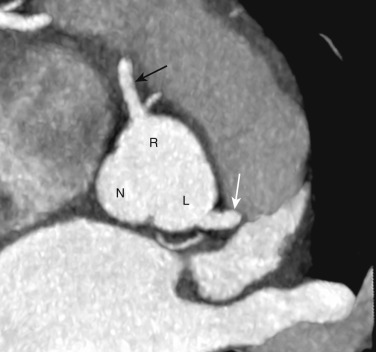
The left main coronary artery arises from the left sinus of Valsalva and courses laterally before dividing. Although it is normally the vessel with the largest diameter compared to the other coronary arteries, it is of variable length. The average length of the left main coronary artery is nearly 1 cm, but this can vary significantly, with lengths ranging from a few millimeters to a few centimeters. In most patients, the left main coronary artery then bifurcates into two vessels, the left anterior descending coronary artery (LAD) and left circumflex coronary artery (LCx) ( Fig. 58-2 ). However, in approximately 20% to 30% of the patients the left main coronary artery will trifurcate, with a ramus intermedius branch arising between the LAD and LCx ( Fig. 58-3 ).
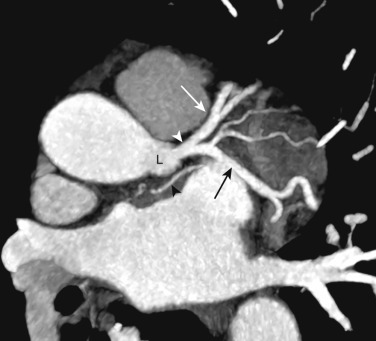
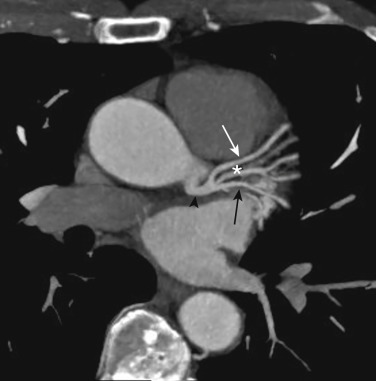
The LAD courses over the anterior surface of the left ventricle (LV) in the anterior interventricular sulcus or groove between the left and right ventricles ( Fig. 58-4 ). Although its diameter can vary between patients, in most the LAD is a large vessel that courses along the anterior surface of the LV. Similar to other coronary arteries, the length of the LAD can vary significantly and can terminate prior to reaching the LV apex, terminate at the LV apex, or wrap around the LV apex to supply the inferior wall at the apical level. The LAD is divided into three portions ( Fig. 58-5 ). The proximal LAD is defined as the portion of the LAD from its origin to the ostium of the first large septal branch or diagonal branch, whichever arises first. The definition of the mid-LAD is defined as the end of the proximal LAD to half the distance to the LV apex. The distal LAD is defined as the end of the mid-LAD to the termination of the LAD.
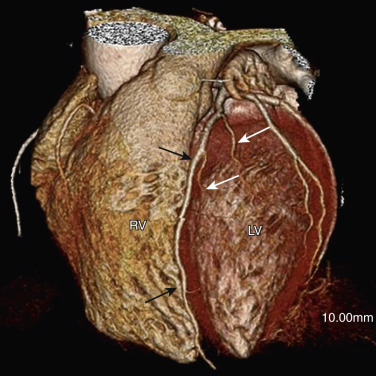
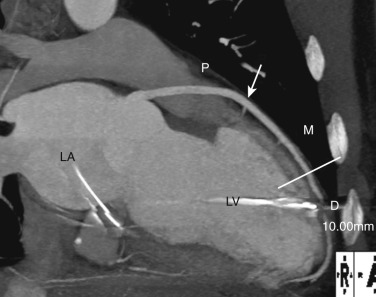
The LAD gives rise to both septal branches and diagonal branches that are important in supplying oxygenated blood to the anteroseptal and anterolateral portions of the LV myocardium, respectively ( Fig. 58-6 ). The septal branches arise from the inferomedial aspect of the LAD and dive into the anterior portion of the interventricular septum. They are usually smaller in size but more numerous than diagonal branches. The diagonal branches arise from the lateral aspect of the LAD and course over the anterolateral aspect of the LV. The number of diagonal branches varies, but in most patients there are between two and four diagonals.
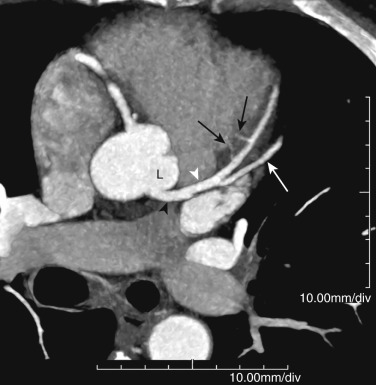
With the bifurcation of the left main, the LAD courses anterior in the anterior interventricular groove while the LCx courses posterolaterally between the LV and left atrium (see Fig. 58-2 ). The LCx gives rise to obtuse marginal (OM) vessels that supply oxygenated blood to the inferolateral aspect of the LV ( Fig. 58-7 ). Similar to diagonal branches, the size and number of OM branches varies between patients. In most patients there are at least two visible OM vessels. Once the LCx reaches the inferolateral aspect of the left atrioventricular (AV) groove and begins to wrap around the inferior aspect of the LV, it is usually a diminutive vessel, since most people are right dominant. In patients who are left or codominant, the distal LCx will be larger in size ( Fig. 58-8 ).
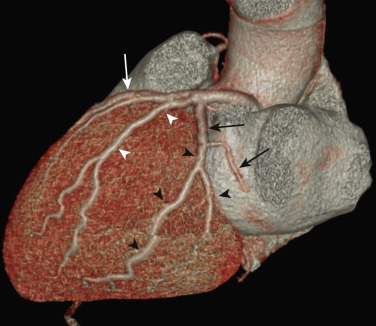
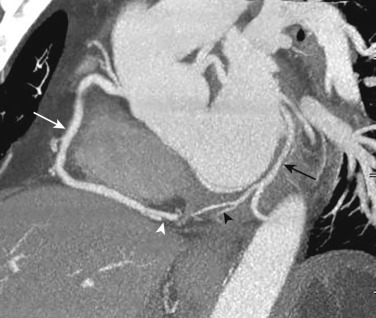
In approximately 20% to 30% of patients the left main coronary artery will trifurcate into the LAD, LCx, and a middle branch called the ramus intermedius or intermediate branch (see Fig. 58-3 ). This branch can vary in size and distribution; in some patients it will course anterolaterally to supply the anterolateral portions of the LV (similar to diagonal branches), whereas in other cases it will course inferolaterally to supply the inferolateral portion of the LV (similar to OM branches).
The right coronary artery (RCA) arises from the anterior-facing right sinus of Valsalva ( Fig. 58-9 ). Since most patients are right dominant the RCA is a large vessel that courses anteriorly in the right AV groove. Similar to the LAD the RCA is divided into three territories ( Fig. 58-10 ). The proximal RCA is defined as the ostium of the RCA to half the distance to the acute margin of the heart. The mid-RCA is defined as the end of the proximal RCA to the acute margin of the heart, and the distal RCA is defined as the end of the mid-RCA to the origin of the posterior descending artery.
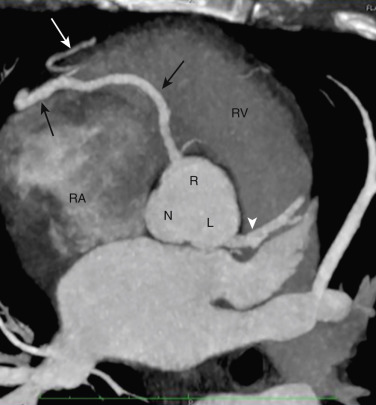
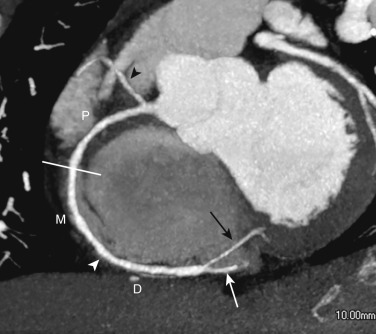
As the RCA courses in the right AV groove, branches arise from the RCA and course anteriorly and extend to the anterior surface of the right ventricle (RV) (see Fig. 58-9 ). Similar to branches of the LAD and LCX, these (acute) marginal arteries vary in size and number. In right dominant patients, the distal RCA will divide into two branches along the undersurface of the heart ( Fig. 58-11 ; see Fig. 58-10 ). These branches are the posterior descending artery (PDA) and posterior lateral branch (PLB).
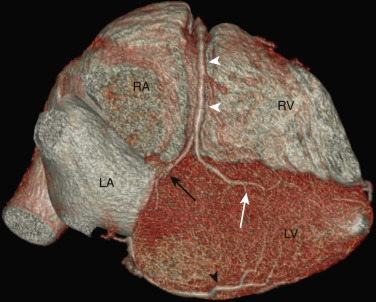
In approximately 75% to 88% of patients, the PDA arises from the RCA, and thus they are considered right dominant (see Figs. 58-10 and 58-11 ). In approximately 9% of patients, the PDA arises from the LCx and the patient is considered left dominant. In a smaller percentage of patients the PDA will arise from the RCA, and a large PLB branch will arise from the LCx; these patients are often considered balanced or codominant (see Fig. 58-8 ).
Whichever vessel gives rise to the PDA, in some ways the PDA is a mirror image of the LAD. While the LAD courses in the anterior interventricular sulcus, the PDA courses in the posterior interventricular sulcus along the inferior aspect of the LV. Similar to the LAD the PDA gives rise to septal branches that supply the inferolateral aspect of the LV septum. The PDA is of variable size and length. In patients with a smaller LAD the PDA tends to be a larger artery and vice versa ( Fig. 58-12 ).

While the PDA courses anteriorly in the posterior interventricular sulcus, the PLB (or posterior lateral ventricular branch [PLVB]) courses laterally and extends along the posterior AV groove between the inferior aspect of the left atrium and LV (see Figs. 58-10 and 58-11 ). It is of variable size and length but usually provides oxygenated blood to the inferolateral base of the LV.
The conus branch is usually the first branch of the RCA ( Fig. 58-13 ), although it can have a separate origin from the right coronary sinus in 17% to 50% of patients ( Fig. 58-14 ). The conus branch extends anteriorly to supply blood to the right ventricular outflow tract (RVOT) or conus. In some instances the conus acts as a collateral pathway for blood flow to the LAD, and this circuit is often referred to as the arterial circle of Vieussens.
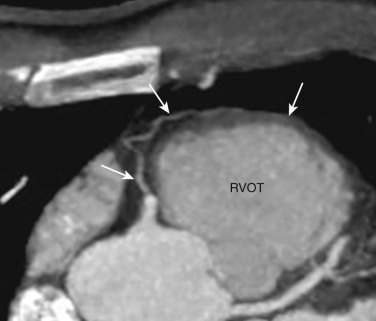
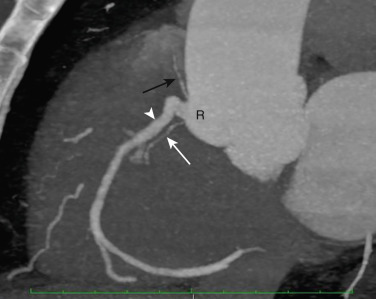
The SA nodal branch is a small vessel that most often originates from the RCA ( Fig. 58-15 ) but arises from the LCx in about one third of patients (see Fig. 58-2 ). Less commonly the SA branch can arise from the left main coronary artery, both the RCA and LCx, or directly from the aorta (see Fig. 58-14 ). Depending on its origin the SA nodal branch courses posteriorly (RCA origin) or medially (LCx origin) and terminates in the region of the SA node, which is located along the posterior aspect of where the superior vena cava enters the right atrium.
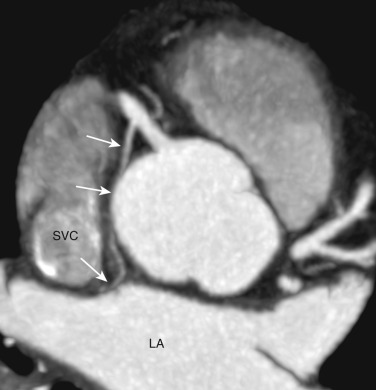
In most patients the AV nodal branch arises from the very distal U-shaped aspect of the distal RCA as is courses superior to the PDA. It is a small vessel that courses superiorly toward the posterior anulus of the mitral valve ( Fig. 58-16 ).
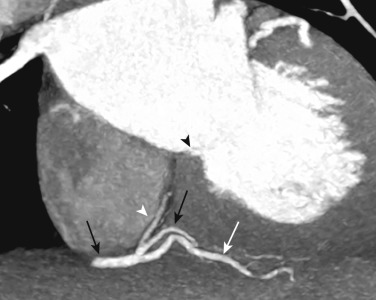
Occurring in between 0.5% and 1.5% of the population, coronary artery anomalies are frequently encountered on cardiac computed tomography (CT). Although many of these anomalies have little clinical significance, anomalous coronary anatomy has been the cause of sudden cardiac death in 5% to 35% of young people. Some of these anomalies can lead to symptoms and thus be the reason for the study; however, they are often clinically silent and are frequently an incidental finding. It is also important to remember that although anomalous coronary anatomy is best visualized with electrocardiographically (ECG)-gated CT angiography (CTA), the improved temporal resolution of modern scanners often allows for basic assessment of coronary anatomy even on nongated thoracic CT scans.
There are many ways to subdivide these anomalies. One of the more commonly used methods is to divide them based on anomalous origin, course, and termination. No matter how one chooses to classify these anomalies, it is important to recognize that although many of the anomalies are benign, others can lead to a reduction in coronary blood flow and major adverse cardiac events. Therefore it is imperative to recognize the various anomalies on imaging as well as their potential clinical ramifications.
Numerous congenital coronary artery anomalies are associated with an anomalous origin of a coronary artery. They may be an isolated finding but can be associated with multiple coronary anomalies, including the presence of a single coronary artery with various anomalous origins and courses. These anomalies include absence of the left main coronary artery, anomalous location of the coronary ostium within the aortic root but near the correct sinus, anomalous location of the coronary ostium outside the aortic root, and anomalous origin of the coronary ostium from the incorrect sinus. Within each of these categories, some anomalies have few clinical repercussions while others can lead to adverse events.
Absence of the left main coronary artery is a benign variant that occurs in approximately 0.4% to 2% of the population. In this situation the LAD and LCx have independent origins from the left sinus of Valsalva ( Fig. 58-17 ).
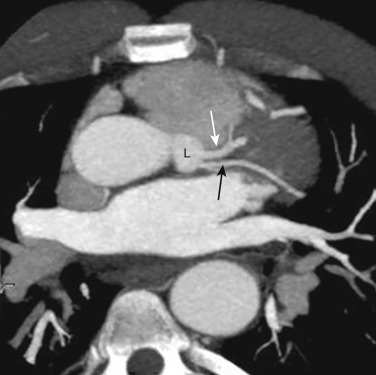
Coronary artery ostia usually arise from the center of their respective aortic sinus. However, in some patients the coronary artery may arise in a slightly eccentric location, although with the correct sinus. For instance a coronary may arise more laterally in the sinus (near one of the valvular commissures), slightly superiorly (near the sinotubular junction), or slightly inferiorly (closer to the valve). Except in rare circumstances, these are considered benign variants.
In certain instances the coronary arteries may arise from a location outside the sinuses. Although some of these anomalies may be potentially malignant, which will be discussed later, many are considered benign variants. For instance, one of the coronary arteries may have a high origin 1 cm or greater above the sinotubular junction and may be seen arising from the ascending aorta or even the aortic arch ( Fig. 58-18 ). This can occur with either the left main or RCA and is a benign anomaly. However, it is important to recognize this anomaly because the vessel could be accidentally injured during ascending aortic surgical manipulation.
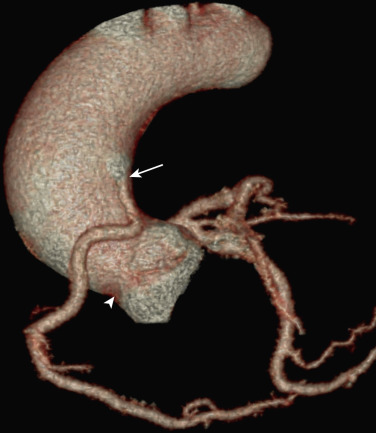
In extremely rare instances a coronary artery can arise from one of the arch vessels (right brachiocephalic, carotid, or subclavian arteries), internal mammary artery, or even the descending thoracic aorta. Given the rarity of these anomalies, their clinical significance is unclear, although in most instances they should not lead to a compromise in blood flow.
In a retroaortic course, the anomalous coronary artery arises from the opposite sinus and courses posteriorly and extends between the aorta and left atrium. This is most commonly seen with the LCx arising from the right sinus of Valsalva, although it can arise directly from the proximal RCA ( Fig. 58-19 ). Less commonly the left main coronary artery can have a retroaortic course and be part of a single coronary anatomy. In rare instances the RCA can arise from the left sinus, with a retroaortic course. These are benign anomalies and require no intervention.
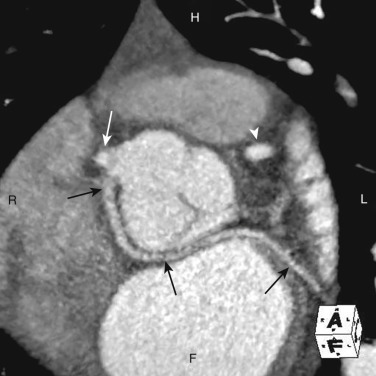
A prepulmonic course occurs when an anomalous coronary artery courses anterior to the RVOT ( Fig. 58-20 ). Most commonly this abnormality involves the LAD or left main coronary artery, which often arises directly from the proximal RCA in the setting of a single coronary artery. If the LAD has a prepulmonic course, the LCx may have a retroaortic course or can arise directly from the left sinus. Less commonly the RCA may have a prepulmonic course in the setting of a single left coronary artery.
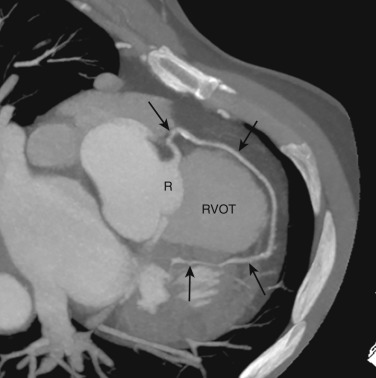
A septal course usually involves the LAD arising from the right coronary sinus. It is important to recognize the inferomedial course of the vessel that dives into the proximal aspect of the LV septum ( Fig. 58-21 ). This anomaly needs to be distinguished from the interarterial, potentially malignant course where the anomalous coronary extends medially between the two outflow tracts. Although it can rarely be associated with myocardial ischemia, in most instances a septal course does not lead to a compromise in coronary blood flow.
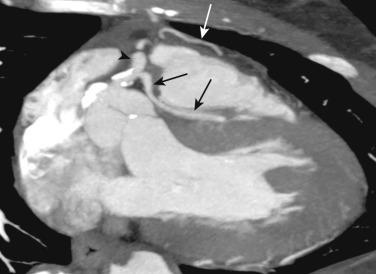
Origin from the noncoronary sinus is an extremely rare anomaly. This can occur with the RCA or left main. Although there is little information on this anomaly given its rarity, it is often considered a benign anomaly.
In an interarterial course, a coronary artery arises from the opposite coronary sinus and courses medially between the two outflow tracts. This can involve the RCA, left main, or LAD. Unlike the retroaortic or septal course, an interarterial course, especially when involving the left main or LAD, can lead to myocardial ischemia, infarction, and sudden cardiac death. The cause of this is believed to be multifactorial. When the artery courses medially, it can experience extrinsic compression between the aorta and pulmonary artery or RVOT. Compression can worsen during exercise, owing to physiologic dilatation of the aorta and pulmonary artery at a time when myocardial oxygen demand increases. Compression is also due to the intramural course of the coronary where it courses in the wall of the aorta. The intramural course can be of varying length and can often be identified on imaging by soft tissue attenuation surrounding the proximal coronary artery, leading to luminal narrowing with an increased height/width ratio ( Fig. 58-22 ). The ostium of the interarterial vessel may be narrowed and is often referred to as slitlike. The proximal vessel can also have a tangential course that leads to proximal kinking of the vessel.

An interarterial course of the RCA (see Fig. 58-22 ) is more common than those involving the left system. In patients with an interarterial course of the RCA, a higher incidence of symptoms and major adverse cardiac events has been reported in those with a higher course of the aberrant vessel between the aorta and pulmonary artery as compared to those with a lower interarterial course between the aorta and RVOT. However, in most patients an interarterial course of the RCA is an asymptomatic finding and does not lead to ischemia. When an interarterial course of the RCA is identified, surgical correction is recommended if the patient has chest pain, ischemia, syncope, presyncope, or demonstrates LV dysfunction in the appropriate vascular territory. If the patient is asymptomatic and this course is an incidental finding, many recommend that the patient undergo a stress test with surgical correction in the setting of inducible ischemia in the affected vascular distribution. If ischemia is absent on stress testing, most currently favor a noninterventional approach.
Compared to the RCA, an interarterial course of the LAD ( Fig. 58-23 ) or left main has a higher association with myocardial ischemia and sudden cardiac death. Because of the high risk of sudden cardiac death with an interarterial course of the left main or LAD, surgical correction is recommended in most cases even if the finding is incidental. This can occur via various techniques including unroofing, reimplantation, or bypass.
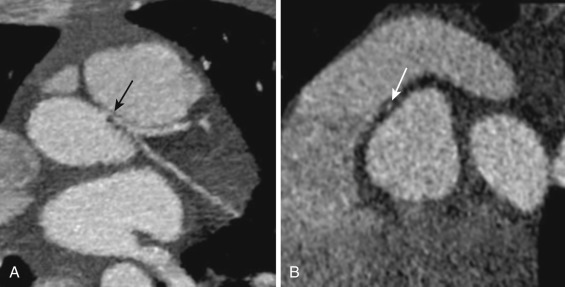
ALCAPA, or Bland-White-Garland syndrome, is a rare congenital anomaly with an estimated incidence of 1 in 300,000 live births. In utero, admixture of blood and high pulmonary pressures allow for adequate perfusion of the left main coronary artery. In the neonatal period, pulmonary pressures remain high enough to allow for adequate perfusion of the left main coronary artery with pulmonary arterial blood. The age of presentation depends on the development of collaterals early in life. When pulmonary artery pressures decrease in the first few months of life, and if adequate collaterals do not develop, poor flow from the pulmonary artery to the left main coronary artery leads to myocardial ischemia, infarct, and cardiac death in 90% of infants in the first year of life ( Fig. 58-24 ). However, if a good collateral system from the RCA to left coronary artery territory exists, the decrease in pulmonary pressure will allow for systemic arterial blood to perfuse the left main territory through collaterals from the RCA. This will create flow from the RCA to the left main and into the main pulmonary artery, leading to a physiologic state similar to a fistula ( Fig. 58-25 ). However, owing to preferential flow into the pulmonary artery, capillary hypoperfusion may lead to chronic subendocardial ischemia, and patients often present in their third or fourth decade of life with subacute symptoms such as angina, dyspnea, palpitations, and fatigue. However, although patients with ALCAPA may be asymptomatically discovered in their eighth decade of life, ventricular arrhythmia and sudden death is still common in this population.
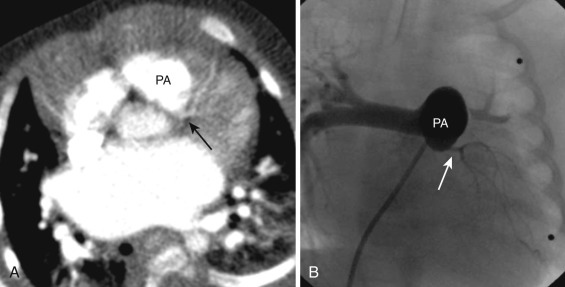
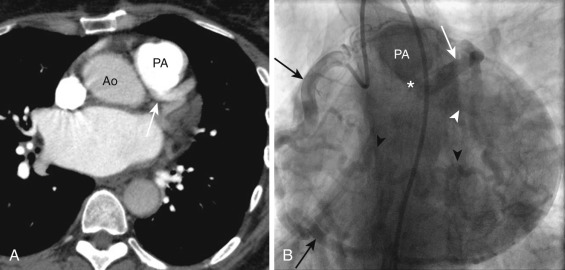
Single coronary anomalies encompass less than 1% of coronary anomalies. In most instances there is a single RCA, although a single left coronary artery can occur (see Fig. 58-21 ). In the setting of a single coronary artery, various anomalous courses can be present, including both benign (retroaortic, prepulmonic, septal, wraparound) and potentially malignant (interarterial) courses. It is important to distinguish a single coronary artery from the even rarer coronary ostial atresia. In most cases of ostial atresia, the proximal left main or RCA will be absent. However, distal to the focal atretic segment, normal coronary artery anatomy will be seen.
An intramyocardial course of a coronary artery is a common incidental finding and has been reported to occur in up to 58% of patients undergoing coronary CTA and up to 86% of autopsies. Bridging most often involves the mid-LAD, where a band of myocardial tissue extends around the vessel ( Fig. 58-26 ). The depth and length of the bridged segment can vary significantly from a few millimeters to a few centimeters. While the vessel is compressed during systole, this rarely leads to symptoms, because the coronary arteries fill during diastole. Although the vast majority of myocardial bridges are an incidental finding on coronary CTA, myocardial bridges can lead to angina and ischemia through various mechanisms including phasic systolic vessel compression, persistent diastolic lumen diameter reduction, increased blood flow velocities, retrograde systolic flow, and reduced coronary flow reserve. In addition there is an increased incidence of coronary artery atherosclerotic disease proximal to the bridge, although the bridged segment is typically free of disease. Although there are no definitive imaging findings that allow for distinction between incidental and symptomatic bridges, deep bridges are more likely to be symptomatic.
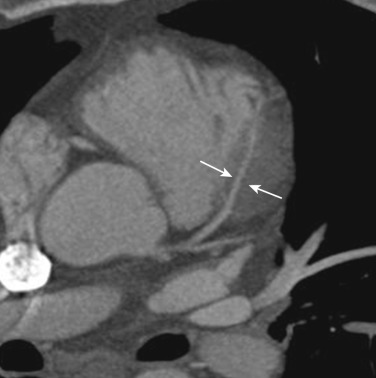
A split, or double, coronary artery is an extremely rare anomaly. In most instances there is one coronary artery arising from the sinus of Valsalva, which then divides in its proximal portion into two parallel coronary arteries that mirror their course ( Fig. 58-27 ). This most commonly involves the RCA, although it has been described with the LAD. Since in most cases there is a single ostia, many have preferred to use the term split to describe this anomaly. In rarer instances there is a true “double” or duplicate coronary artery where each has an independent origin from the aortic sinus, with near parallel courses. However, there is continued debate regarding the terminology. In general this is a benign anomaly.
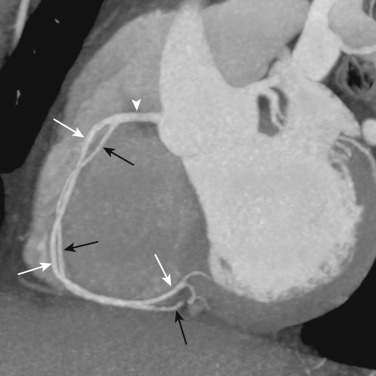
Coronary artery fistulas may be acquired but are most often congenital. Fistulas can involve either the left or right coronary systems, and the literature varies on which distribution is most common. No matter which coronary artery is involved, drainage is most commonly to the right side (from the coronary sinus to the pulmonary artery) and physiologically acts like a left-to-right shunt. In nearly all cases the involved coronary artery is markedly dilated and tortuous, and such a finding on CT should lead to suspicion of a fistula ( Fig. 58-28 ). Although a fistula can be an incidental finding, patients may present with congestive heart failure due to long-standing shunt, ischemia due to a steal phenomenon (preferential flow of blood through lower-pressure fistula instead of through higher-pressure capillary bed), or endocarditis.
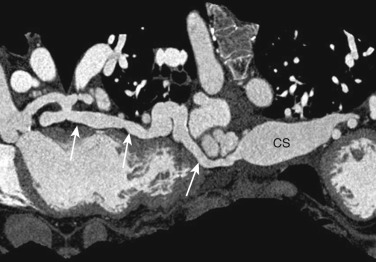
Mapping of the coronary veins on cardiac CT is often valuable prior to biventricular pacer placement and transcoronary vein ablation. The coronary sinus provides drainage for most of the cardiac veins. It is located in the posterior AV groove and empties into the right atrium ( Fig. 58-29 ). Its major feeding vessels are the great cardiac vein and middle cardiac vein. The larger coronary veins typically run parallel to the coronary arteries.
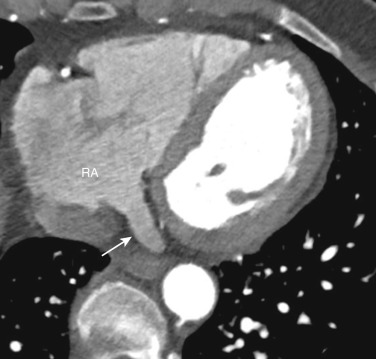
The proximal portion of the great cardiac vein is adjacent to the LAD, where it is often denoted as the anterior interventricular vein. More distally the great cardiac vein curves into the posterior AV and extends inferiorly to drain into the coronary sinus ( Fig. 58-30 ). The middle cardiac vein lies adjacent to the PDA in the posterior interventricular groove. It extends posteriorly and drains into the coronary sinus. The small cardiac vein runs parallel to the RCA in the anterior interventricular groove. It extends inferiorly to terminate in the coronary sinus. Small cardiac veins anterior to the RV drain directly into the right atrium. A small vein posterior to the left atrium, the oblique vein of Marshall, provides a connection between the coronary sinus and a left superior vena cava in patients with this abnormality.
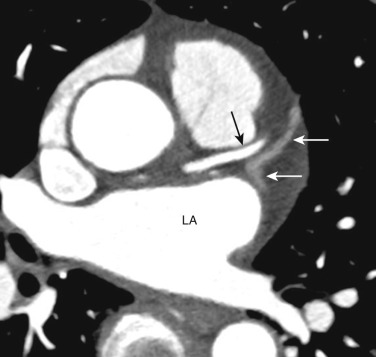
To optimize image quality, it is critical to properly prepare the patient and select the appropriate imaging protocol that takes into account the indication for the study. Prior to the scan, it is important to explain the procedure to the patient, determine that there are no contraindications to premedication or intravenous (IV) contrast, and coach the patient on breath holding. Appropriate contrast protocols and scanner acquisition techniques are essential.
Become a Clinical Tree membership for Full access and enjoy Unlimited articles
If you are a member. Log in here